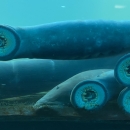Lampreys are obligate ectotherms and directly influenced by the ambient water temperature. In lamprey species other than Pacific Lamprey, evidence exists that lethal water temperatures for larvae occur near 27.0-31.0°C (e.g., Potter and Beamish 1975; Arakawa and Yanai 2021). Although few studies have addressed the thermal tolerance of Pacific Lamprey, recent investigations indicated the ultimate upper incipient lethal temperature (UUILT) for larvae exceeds 27.5°C (Whitesel and Uh, 2022) and provided preliminary evidence that larvae have the ability to occupy natural areas warmer than 27.5°C (Whitesel and Sankovich 2022; Sankovich and Whitesel 2022a, 2022b). How climate change climate change
Climate change includes both global warming driven by human-induced emissions of greenhouse gases and the resulting large-scale shifts in weather patterns. Though there have been previous periods of climatic change, since the mid-20th century humans have had an unprecedented impact on Earth's climate system and caused change on a global scale.
Learn more about climate change will ultimately influence the status of Pacific Lamprey is uncertain (see Wang et al. 2020). Currently, many of the locations where Pacific Lamprey rear naturally experience maximum water temperatures near 26.0°C. With predictions that during the next 25-35 years air temperatures in the Pacific Northwest may rise 2-5°C (Wu et al. 2012), maximum water temperatures where some Pacific Lamprey exist now may exceed the lethal limit for larvae. Whether there are effects on larvae at warm but sublethal temperatures is not well understood. We propose to investigate the effects of sublethally warm stream temperatures on larval Pacific Lamprey, specifically with respect to their growth, behavior, and physiology.
Publication date
Type of document
Annual Report
Facility
Media Usage Rights/License
Public Domain
Program
Species
FWS Focus
FWS and DOI Region(s)





